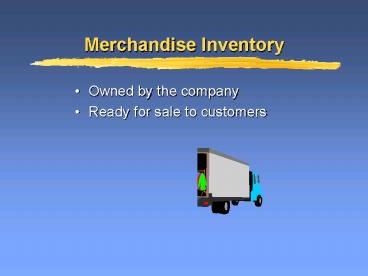Merchandise Inventory PowerPoint PPT Presentation
1 / 27
Title: Merchandise Inventory
1
Merchandise Inventory
- Owned by the company
- Ready for sale to customers
2
What We Learn Today
- Cases of inclusion of inventory
- Allocation between ending inventory and COGS
3
Manufacturing Inventory
Raw materials
- Finished goods inventory
Work in process
4
Determining Inventory Quantities
- A physical inventory count
- Determines ending inventory
- Enables cost of goods sold to be calculated
Companies that use a perpetual inventory
system must also take a physical inventory to
check the accuracy of book inventory against
actual inventory
5
Taking a Physical Inventory
- Determining inventory quantities by counting,
weighting or measuring each type of inventory - Determining ownership of goods, including goods
in transit and consigned goods
6
Goods in Transit
- Goods on board a truck, train, ship, or plane at
the end of the period - Who includes goods in transit in inventory? The
buyer? The seller? - Goods in transit are included in the inventory of
the company with legal title
7
Ownership passes to buyer here
Illustration 6-1
FOB Shipping Point
Public Carrier Co.
Seller
Buyer
Ownership passes to buyer here
FOB Destination Point
Public Carrier Co.
Seller
Buyer
8
Consigned Goods
- Goods in your store that you dont pay for until
they sell - Company does not take ownership
9
Inventory Costing
- After calculating the quantity of units of
inventory, unit costs are applied - This determines the values for the cost of goods
sold and ending inventory - This is a complicated process because inventory
is purchased at different times
10
Inventory Valuation Systems
- The following inventory valuation methods are
generally accepted. They can be used in either a
periodic or perpetual inventory system. - Specific Identification
- Cost Flow Assumptions
- Average cost
- First-in, first-out (FIFO)
- Last-in, first-out (LIFO)
11
Specific Identification
- Concentrates on the physical tracing of the
particular items sold - Major limitation is in identifying the particular
item sold - Used in low-volume, high-priced industries
- e.g., jewellery stores
12
Average Cost Flow Assumption
- The average cost of all units in inventory is
calculated each time there is a purchase - Weighted average cost
- This cost is used to determine cost of goods sold
and inventory - Major advantage is not having to track the
individual items of inventory
13
Weighted Average Cost
14
First-in, First-out (FIFO)
- The assumption is that the first item purchased
is the first item sold - Inventory is valued at the most current cost and
cost of goods sold is valued at the oldest
inventory cost - Earnings reported using this cost flow assumption
is higher than any other cost flow assumption as
the oldest costs are used to determine cost of
goods sold
15
First-in, First-out (FIFO)
Cost of Goods Sold
Oldest Costs
Ending Inventory
Recent Costs
16
Last-in, First-out (LIFO)
- The assumption is that the last item purchased is
the first sold - Inventory is valued at oldest cost and cost of
goods sold is valued at current cost - This method while allowed under GAAP, is not
permitted for income tax purposes
17
Last-in, First-out (LIFO)
Cost of Goods Sold
Recent Costs
Ending Inventory
Oldest Costs
18
Financial Statement Effects
What are the effects on the balance sheet and
statement of earnings if prices are assumed to be
rising?
19
Financial Statement Effects
What are the effects on the balance sheet and
statement of earnings if prices are assumed to be
falling?
20
Financial Statement Effects
What are the effects on the balance sheet and
statement of earnings if prices are assumed to be
stable?
All three cost flow assumptions will give the
same results.
21
Use of Cost Flow Assumptions by Canadian Companies
- Each of the cost flow assumptions are acceptable
in Canada - Very few companies use LIFO as it is not
permitted for income tax purposes in Canada
22
Inventory Errors
- Errors can occur in accounting for inventory
- When errors occur they affect both the statement
of earnings and the balance sheet - An error in ending inventory can affect the
calculation of cost of goods sold and net
earnings in two periods
23
Lower of Cost and Market (LCM)
- When the value of the inventory declines below
cost, it is written down to its market value - Market is defined as net realizable value (or
current replacement cost), not selling price
24
Lower of Cost and Market (LCM)
- Departure from cost principle
- Follows conservatism concept
- Used only after one of the cost flow assumptions
(specific identification, FIFO, LIFO, or average
cost) is applied
25
How Much Inventory Should a Company Have?
- Only enough for sales needs
- Excess inventory costs
- Storage costs
- Interest costs
- Obsolescence
26
Inventory Turnover
27
Days in Inventory

